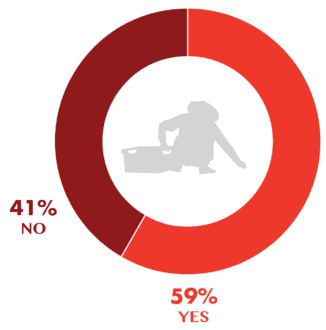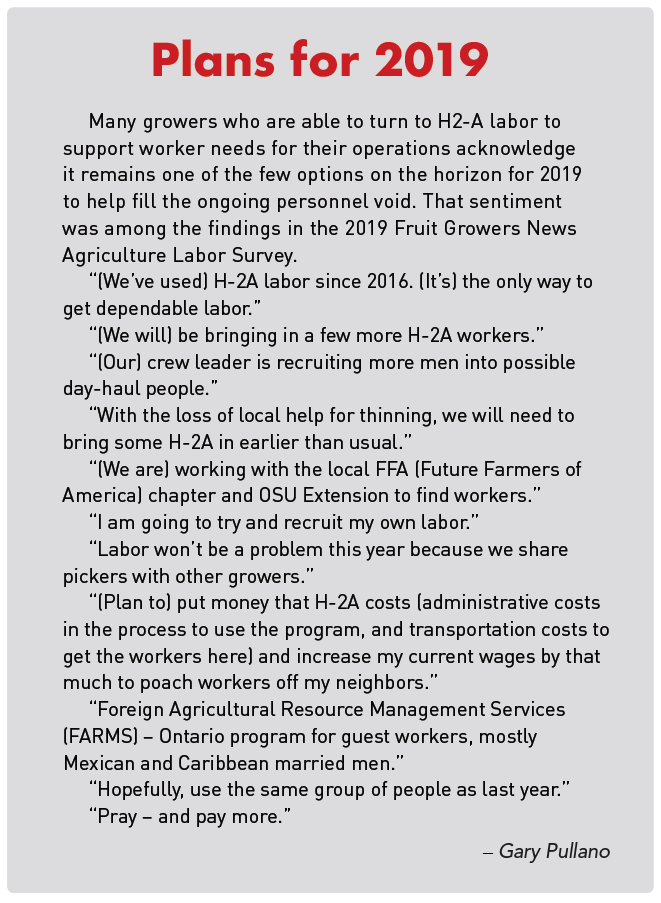

May 30, 2019Survey shows workforce deficiencies for growers
Scarce labor availability continued to plague fruit growers in 2018, according to responses to an agriculture labor survey conducted by Fruit Growers News.
Inching up one percentage point from 2017’s FGN survey tally, 41% of respondents indicated they experienced severe worker shortages in 2018. Efforts continue on a broad scale to secure labor in order for growers to grow, tend and harvest their crops.
The survey – conducted in the first quarter of 2019 – asked fruit-growing operations if they had enough labor in 2018. Just over 58% indicated they did have adequate worker numbers for the previous season. Growers had reported nearly identical results in 2017 worker turnout, compared to even more deficient worker totals in 2016.


The percentage of worker openings in 2018 reached as high as 90% on one responding farm.
Farms that fell short of their required worker numbers in 2018 pursued a number of strategies to make up the difference, including working more with less.
“We didn’t harvest at optimum time and borrowed workers,” said one respondent.
Some other impacts included losing money and cutting costs. Some planted fewer acres, dipped into savings, worked longer hours and “did it myself and got volunteers.”
“There is no way to make it up. It is money lost,” lamented one respondent.
Another said: “It cost money (and led to) a profit reduction for the company, less taxes paid, etc.”
Some scraped by with new approaches the best they could. “(We) had significant production to carry through (with) sales close to the previous year.”
“We began a U-pick option at our blueberry farm,” a grower said. “It has been very successful.” One found a unique way to generate something out of nothing – “we made bootleg booze,” they said.
Fully 50% of the respondents indicated they left at least some of their crop unharvested in the field or orchard.
In one instance, the harvest itself was carried out, but the labor shortage led to a “storage condition that was compromised.”
H-2A a sketchy option


“Many growers are hoping to go back in time – lots of cars full of people wanting to pick apples. Well, that ship has sailed and is not coming back. (There’s) lots of complaining about not enough help – but they don’t want to bite the bullet and go (H-2A).”
Just 38 percent said they used the program in 2017, with 62% not pursuing that option among survey returners. But in 2018, 53% of growers who took the survey used H-2A workers, while 47% said they did not.
While many H-2A users said they experienced positive impacts from using the visa workers – (“I like that I can count on them being there. I dislike the cost.”) – the good experiences were balanced against an unwieldy and burdensome process.
“We love the reliability of the labor. The cost at times is high, but the return per worker we have found to justify that cost.”
“(I) like having strong, serious, hard-working people under 60 years old.”
“(They) are dependable, hard-working and take pride in their work.”
“It’s the only way to farm,” one said.
Many found the program “reliable but expensive.”
“(We had) good workers. (I) did not like that we had to waste time with people throughout the halfway mark to interview and possibly hire.”
“(They’re) mostly good workers (but) the wages are getting too high.”
Some negative comments:
“It took 6 months and I was into the start of harvest and it was still not approved.”
“Housing, transportation, food shopping, laundry. It’s like having a bunch of kids to take care of.”
“Workers are available, but wages are eventually going to destroy the family farm.”
“The workers are reliable. The wage is way too high and out of control. The wages have increased 50% since we started H-2A eight years ago and our commodity prices are flat at best. Our profits have decreased to nearly nothing.”
“(The) peace of mind is good. Loss of flexibility and costs are negative. (We) should be able to share workers when we are slow and neighbors need help.”
“If we didn’t have H-2A workers, we probably would not have been able to get the entire crop off last year.”
“I like the contract lock-in. I hate the large price tag the contractors charge to administer the program.”
“The AEWR (Adverse Effect Wage Rate) is increasing at a ridiculous rate. The program needs to be streamlined so we can get workers in a timelier fashion.”
“It’s so expensive growing winegrapes on the East Coast as it is. I don’t understand why this adverse wage crap is thrown in. Locals say they want the job, and last three days, or show up when they want. These are not high-paying jobs. Walmart’s paying $15 an hour. It’s tough out here.”
“I grow blueberries, so I need workers when the berries are ready to pick. We have no control over weather. We do have a harvester but we want to pick fresh market by hand. (We) may have to go to (the) harvester earlier than expected if labor is short.”
“The H-2A program brings additional issues to employers. This program falls under the jurisdiction of (the) Department of Labor (DOL) and a visit from DOL can be costly if you aren’t prepared.”
Many pointed to government inaction regarding labor reform issues, including the lack of sensible immigration rule-making.
“Between immigration and trade policy, ag is in big trouble,” one respondent said.
“If the wage rate is not fixed and lowered, our farm and many others that haven’t went broke yet will do so very soon. We cannot compete with products from other countries that are paying our hourly wage for a day’s work. Between unfair trade and out of control wage increases all coming from government, we soon will be a country that depends on someone else for our entire food supply. The H-2A system needs repair quickly.”
“We need immigration reform now. It is absolutely ridiculous that our politicians cannot work together on this. A group of ordinary citizens could figure it out in a few days, if not hours.”
Wage rate average
Survey respondents indicated they pay farmworkers an average of approximately $14.29 an hour for harvesting their fruit crops.
A few of the growers using the H-2A program were impacted by their state’s AEWR, the rate participating farms must pay all workers – including their domestic help. This bumped several operations to $20 an hour or higher for 2018.
The lowest pay reported was $8 an hour.
Using piece rate also brings adjustment to the wage averages.
– Gary Pullano, managing editor















